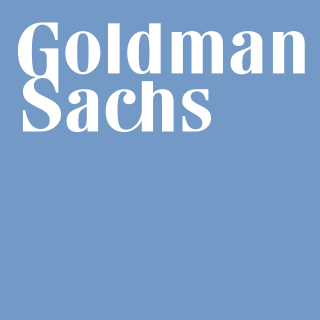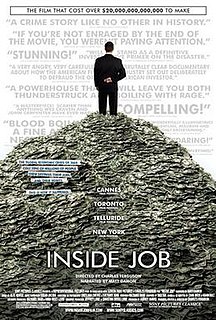
The Goldman Sachs Group, Inc., is an American multinational investment bank and financial services company headquartered in New York City. It offers services in investment management, securities, asset management, prime brokerage, and securities underwriting.

The Bank of America Corporation is an American multinational investment bank and financial services company headquartered in Charlotte, North Carolina, with central hubs in New York City, London, Hong Kong, Minneapolis, and Toronto. Founded in San Francisco, Bank of America was formed through NationsBank's acquisition of BankAmerica in 1998. It is the second largest banking institution in the United States, after JPMorgan Chase. As a part of the Big Four, it services approximately 10.73% of all American bank deposits, in direct competition with Citigroup, Wells Fargo, and JPMorgan Chase. Its primary financial services revolve around commercial banking, wealth management, and investment banking.
Lehman Brothers Holdings Inc. was a global financial services firm. Before filing for bankruptcy in 2008, Lehman was the fourth-largest investment bank in the United States, doing business in investment banking, equity and fixed-income sales and trading, research, investment management, private equity, and private banking. Lehman was operational for 158 years from its founding in 1850 until 2008.

The Bear Stearns Companies, Inc. was a New York-based global investment bank, securities trading and brokerage firm that failed in 2008 as part of the global financial crisis and recession, and was subsequently sold to JPMorgan Chase. The company's main business areas before its failure were capital markets, investment banking, wealth management, and global clearing services, and it was heavily involved in the subprime mortgage crisis.

A collateralized debt obligation (CDO) is a type of structured asset-backed security (ABS). Originally developed as instruments for the corporate debt markets, after 2002 CDOs became vehicles for refinancing mortgage-backed securities (MBS). Like other private label securities backed by assets, a CDO can be thought of as a promise to pay investors in a prescribed sequence, based on the cash flow the CDO collects from the pool of bonds or other assets it owns. Distinctively, CDO credit risk is typically assessed based on a probability of default (PD) derived from ratings on those bonds or assets. The CDO is "sliced" into "tranches", which "catch" the cash flow of interest and principal payments in sequence based on seniority. If some loans default and the cash collected by the CDO is insufficient to pay all of its investors, those in the lowest, most "junior" tranches suffer losses first. The last to lose payment from default are the safest, most senior tranches. Consequently, coupon payments vary by tranche with the safest/most senior tranches receiving the lowest rates and the lowest tranches receiving the highest rates to compensate for higher default risk. As an example, a CDO might issue the following tranches in order of safeness: Senior AAA ; Junior AAA; AA; A; BBB; Residual.

E-Trade Financial Corporation offers an electronic trading platform to trade financial assets including common stocks, preferred stocks, futures contracts, exchange-traded funds, options, mutual funds, and fixed income investments. It also provides services for employee stock ownership plans, advisor services, margin lending, online banking, and cash management services.
Banc of America Securities LLC (BAS), was the investment banking subsidiary of Bank of America until it was merged with Merrill Lynch after that firm's acquisition in 2008 to become Bank of America Merrill Lynch. Headquartered in New York City, the company competed in both the domestic and international equity and investment banking markets.

Merrill Lynch & Co., formally Merrill Lynch, Pierce, Fenner & Smith Incorporated, was a publicly-traded American investment bank that existed independently from 1914 until January 2009 before being acquired by Bank of America and rolled into BofA Securities.
A primary dealer is a firm that buys government securities directly from a government, with the intention of reselling them to others, thus acting as a market maker of government securities. The government may regulate the behaviour and number of its primary dealers and impose conditions of entry. Some governments sell their securities only to primary dealers; some sell them to others as well. Governments that use primary dealers include Australia, Belgium, Brazil, Canada, China, France, Hong Kong, India, Italy, Japan, Singapore, Spain, the United Kingdom, and the United States.
Earnest Stanley O'Neal is an American business executive who was formerly chairman and chief executive of Merrill Lynch having served in numerous senior management positions at the company prior to this appointment. O'Neal was criticized for his performance during his tenure as chief executive at Merrill Lynch, where he oversaw the deterioration of the firm's stability and capital position, which resulted in his ouster in September 2007, and the firm's eventual fire sale to Bank of America one year later. Prior to his tenure as Chairman and CEO, Merrill Lynch had thrived as a stand-alone company since 1914.
The United States subprime mortgage crisis was a nationwide financial crisis, occurring between 2007 and 2010, that contributed to the U.S. recession of December 2007 – June 2009. It was triggered by a large decline in home prices after the collapse of a housing bubble, leading to mortgage delinquencies, foreclosures, and the devaluation of housing-related securities. Declines in residential investment preceded the recession and were followed by reductions in household spending and then business investment. Spending reductions were more significant in areas with a combination of high household debt and larger housing price declines.
The subprime mortgage crisis impact timeline lists dates relevant to the creation of a United States housing bubble and the 2005 housing bubble burst and the subprime mortgage crisis which developed during 2007 and 2008. It includes United States enactment of government laws and regulations, as well as public and private actions which affected the housing industry and related banking and investment activity. It also notes details of important incidents in the United States, such as bankruptcies and takeovers, and information and statistics about relevant trends. For more information on reverberations of this crisis throughout the global financial system see Financial crisis of 2007–2008.
Credit rating agencies (CRAs)—firms which rate debt instruments/securities according to the debtor's ability to pay lenders back—played a significant role at various stages in the American subprime mortgage crisis of 2007–2008 that led to the great recession of 2008–2009. The new, complex securities of "structured finance" used to finance subprime mortgages could not have been sold without ratings by the "Big Three" rating agencies—Moody's Investors Service, Standard & Poor's, and Fitch Ratings. A large section of the debt securities market—many money markets and pension funds—were restricted in their bylaws to holding only the safest securities—i.e. securities the rating agencies designated "triple-A". The pools of debt the agencies gave their highest ratings to included over three trillion dollars of loans to homebuyers with bad credit and undocumented incomes through 2007. Hundreds of billions of dollars' worth of these triple-A securities were downgraded to "junk" status by 2010, and the writedowns and losses came to over half a trillion dollars. This led "to the collapse or disappearance" in 2008–09 of three major investment banks, and the federal governments buying of $700 billion of bad debt from distressed financial institutions.
Magnetar Capital is a hedge fund based in Evanston, Illinois. The firm was founded in 2005 and invests in fixed income, energy, quantitative and event-driven strategies. The firm was actively involved in the collateralized debt obligation (CDO) market during the 2006–2007 period. In some articles critical of Magnetar Capital, the firm's arbitrage strategy for CDOs is described as the "Magnetar trade".

Inside Job is a 2010 American documentary film, directed by Charles Ferguson, about the late-2000s financial crisis. Ferguson, who began researching in 2008, says the film is about "the systemic corruption of the United States by the financial services industry and the consequences of that systemic corruption". In five parts, the film explores how changes in the policy environment and banking practices helped create the financial crisis.
E. A. Pierce & Co. was a securities brokerage firm based in New York City. Founded as A. A. Housman & Co., the firm was renamed for Edward A. Pierce in 1927. In 1930, following the stock market crash of 1929 E. A. Pierce acquired the brokerage business of Merrill Lynch. Ten years later, Merrill Lynch merged with E. A. Pierce.

Winthrop Hiram "Win" Smith was an American businessman and investment banker. He was notable as a name partner of Merrill Lynch, Pierce, Fenner & Smith.

Keith A. Schooley is an American author and former stockbroker at Merrill Lynch, who brought attention to fraud and corruption within the firm at the Oklahoma and Texas offices in 1992 as a whistleblower. As a result, he was terminated from the firm, and sued the corporation in a case that went to the Oklahoma Supreme Court, and Tenth Circuit Court of Appeals.













